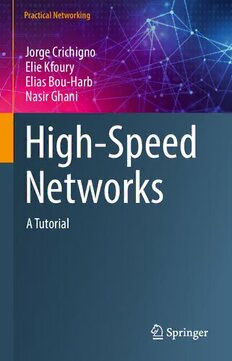
High speed Networks Tutorial (2022)[Crichigno et al][97809701124159783030888411] PDF
Preview High speed Networks Tutorial (2022)[Crichigno et al][97809701124159783030888411]
Practical Networking Jorge Crichigno Elie Kfoury Elias Bou-Harb Nasir Ghani High-Speed Networks A Tutorial Practical Networking SeriesEditor Zhi-LiZhang Sci&Eng,4-192EE/CSBldg UniversityofMinnesota,DeptofComp Minneapolis,MN,USA Explosive growth in cloud and mobile computing coupled with new advances in systems and networking technologies as well as machine learning and artificial intelligence (AI) have revolutionized how networks and distributed systems are designed, developed, operated and managed. This is epitomized by data center networking where it has spurred a wholesale rethinking and re-designs from network architectures, to physical interconnects to routing, flow management and network application support. New networking paradigms and technologies such as software-defined networking, network function virtualization, smart NICs and software/hardware co-designs have emerged for better designing, operating, managing and evolving networks, and also enabled new visions such as “self- driving networks” and AIOps. The Practical Networking Series is centered on emergingtopicsinnewnetworkingparadigms,architecturaldesigns,algorithmsand mechanisms for primarily wired networks (from data center networks, enterprise networkstoISPnetworks),butalsotoucheson“packetcorenetworks”foremerging 5G and beyond cellular and wireless networks. Books in this series address these topics from both theoretical (e.g., new theoretical foundations, algorithms and performance analysis) and practical (e.g., new network mechanisms, protocols, APIsandstandards,softwareframeworks) perspectives. Relatively shortbooks on a timely and focused topic, research monographs, and textbooks are of interest. The Editor is seeking well written works by well-established researchers and practitionersinthenetworkingfieldaroundtheworld,particularlyAsiaandNorth America. ProspectiveAuthorsorEditors: Ifyouhaveanideaforabook,wewouldwelcometheopportunitytoreviewyour proposal.Shouldyouwishtodiscussanypotentialprojectfurtherorreceivespecific informationregardingourbookproposalrequirements,pleasecontactZhi-LiZhang orSusanEvans: Zhi-LiZhang DepartmentofComputerScienceDepartment UniversityofMinnesota 4-192KellerHall,200UnionStreetSE Minneapolis,MN55455-0159 [email protected] SusanEvans SeniorEditor SpringerNature 233SpringeStreet NewYork,NY10013USA [email protected] Moreinformationaboutthisseriesathttps://link.springer.com/bookseries/16325 Jorge Crichigno • Elie Kfoury • Elias Bou-Harb Nasir Ghani High-Speed Networks A Tutorial JorgeCrichigno ElieKfoury CollegeofEngineeringandComputing CollegeofEngineeringandComputing UniversityofSouthCarolina UniversityofSouthCarolina Columbia,SC,USA Columbia,SC,USA EliasBou-Harb NasirGhani CyberCenterforSecurityandAnalytics ElectricalEngineering UniversityofTexasatSanAntonio UniversityofSouthFlorida SanAntonio,TX,USA Tampa,FL,USA ISSN2662-1703 ISSN2662-1711 (electronic) PracticalNetworking ISBN978-3-030-88840-4 ISBN978-3-030-88841-1 (eBook) https://doi.org/10.1007/978-3-030-88841-1 ©TheEditor(s)(ifapplicable)andTheAuthor(s),underexclusivelicensetoSpringerNatureSwitzerland AG2022 Thisworkissubjecttocopyright.AllrightsaresolelyandexclusivelylicensedbythePublisher,whether thewholeorpartofthematerialisconcerned,specificallytherightsoftranslation,reprinting,reuse ofillustrations,recitation,broadcasting,reproductiononmicrofilmsorinanyotherphysicalway,and transmissionorinformationstorageandretrieval,electronicadaptation,computersoftware,orbysimilar ordissimilarmethodologynowknownorhereafterdeveloped. Theuseofgeneraldescriptivenames,registerednames,trademarks,servicemarks,etc.inthispublication doesnotimply,evenintheabsenceofaspecificstatement,thatsuchnamesareexemptfromtherelevant protectivelawsandregulationsandthereforefreeforgeneraluse. Thepublisher,theauthors,andtheeditorsaresafetoassumethattheadviceandinformationinthisbook arebelievedtobetrueandaccurateatthedateofpublication.Neitherthepublishernortheauthorsor theeditorsgiveawarranty,expressedorimplied,withrespecttothematerialcontainedhereinorforany errorsoromissionsthatmayhavebeenmade.Thepublisherremainsneutralwithregardtojurisdictional claimsinpublishedmapsandinstitutionalaffiliations. ThisSpringerimprintispublishedbytheregisteredcompanySpringerNatureSwitzerlandAG Theregisteredcompanyaddressis:Gewerbestrasse11,6330Cham,Switzerland Preface WelcometoHigh-SpeedNetworks:ATutorial.Thisbookistheresultofajourneyof theauthorswhohavebeendesigninganddeployinghigh-speednetworksforseveral years, in particular Science Demilitarized Zones (Science DMZs). The Science DMZisahigh-speednetworkdesignedtofacilitatethetransferofbigsciencedata. As the popularity of high-speed networks and Science DMZs surged, the need forprofessionalswiththeskillstooperatesuchinfrastructureshasincreased.How- ever, practitioners have been mostly trained to operate general-purpose networks, which have different characteristics from those of Science DMZs and other high- performancenetworks.Atthetimewhentheauthorsstarteddesigningandoperating ScienceDMZs,theavailablematerialwaslimitedtoworkshopsorganizedbyESnet, theScientificNetworkingDivisionatLawrenceBerkeleyNationalLaboratoryinthe UnitedStates(U.S.). This book tries to address the above gap. It provides practical knowledge and skillsonScienceDMZsandhigh-speednetworksingeneral,whicharereinforced withvirtuallaboratoryexperiments. Audience This book is for industry professionals and for students in computer science, information technology, and similar programs, who are interested in learning fundamental concepts related to high-speed networks and corresponding imple- mentations. The book assumes minimal familiarity with networking, typically covered in an introductory networking course. It is appropriate for an upper-level undergraduatecourse,forafirst-yeargraduatecourse,andforself-pacelearningby industryprofessionals. v vi Preface What is UniqueAbout This Book? The book delves into protocols and devices at different layers, from the physical infrastructure to application-layer tools and security appliances, that must be carefully considered for the optimal operation of Science DMZs and high-speed networks. In contrast to traditional books, the book is accompanied by hands-on virtuallaboratoryexperimentsthatareconductedonavirtualplatform. The VirtualPlatformandVirtualLaboratoryExperiments The virtual platform enables learners to immediately deploy virtual networks composedofanequipmentpod(routers,switches,servers,firewalls,etc.)neededfor masteringatopic.Experimentshelplearnerstoreinforceconceptsandtolearnhow to optimally configure and manage network devices, based on real measurements and observations. Access to the platform is available for a fee and includes all material required to conduct the experiments. The URL of the virtual platform is: http://highspeednetworks.net/ Organization Thebookfollowsabottom-upapproach.Chapter“IntroductiontoHigh-SpeedNet- worksandScienceDMZ”presentsthemotivationforScienceDMZsandhigh-speed networks. Chapter “Network Cyberinfrastructure Aspects for Big Data Transfers” describes limitations of general-purpose networks when transferring large data sets across a Wide Area Network (WAN), and explores the cyberinfrastructure required to support such transfers. It also discusses different options a network may have to connect to other networks. Chapter “Data-Link and Network Layer ConsiderationsforLargeDataTransfers”describesattributesrelatedtoroutersand switches, which have large impact on performance, including router’s buffer size, maximumtransmissionunit(MTU),andothers.Chapter“ImpactofTCPonHigh- Speed Networks and Advances in Congestion Control Algorithms” discusses key featuresatthetransportlayer,suchasTCPcongestioncontrol,pacing,andparallel connections.Chapter“ApplicationandSecurityAspectsforLargeFlows”presents application-layer tools used to support large data transfers. Chapter “Security Aspects” describes security challenges arising in Science DMZs and high-speed networks, and presents best practices. Chapter “Challenges and Open Research Issues”discusseschallengesandopenresearchissues. Preface vii RelevanceofNetworkingTools The book provides a set of virtual laboratory experiments at the end of most chapters.Allequipmentpodsareimplementedwithappliancesrunningrealprotocol stacks. Examples include iPerf3, the Network Emulator (NETEM), traffic control (tc), and Zeek intrusion detection system. Recognizing the impact of Mininet on networking, the authors decided to use this network emulator to create topologies forthelaboratoryexperiments.Alltoolsarebasedonopen-sourcesoftware,which reflectsindustrytrends.Specifically,overtheyears,theauthorsobservedthatopen- source software has been increasingly used to design, build, test, and control networks. For example, since the original publication of the paper describing Mininet in 2010, Mininet has gained wide adoption in the industry and academia. Mininet’spaperhasreceivedtheACMTestofTimeAward. Columbia,SC,USA JorgeCrichigno Columbia,SC,USA ElieKfoury SanAntonio,TX,USA EliasBou-Harb Tampa,FL,USA NasirGhani Acknowledgement The authors would like to express their gratitude to the U.S. National Science Foundation (NSF), Office of Advanced Cyberinfrastructure (OAC). This work would not be possible without NSF support. Part of the material was developed under the award numbers 1829698 and 1925484. The authors are also thankful to the Network Development Group (NDG) team who worked with Dr. Crichigno to deploy the virtual laboratory experiments. NDG’s president, Richard Weeks, has constantlyprovidedinvaluablesuggestions. ThefirsttwoauthorswouldliketospeciallythankthemembersoftheCyberin- frastructureLaboratoryattheUniversityofSouthCarolina(USC)whohelpedcreate and test laboratory experiments, and the Department of Integrated Information TechnologyatUSCfortheconduciveenvironmentforwritingthisbook. ix Contents IntroductiontoHigh-SpeedNetworksandScienceDMZ................... 1 NetworkCyberinfrastructureAspectsforBigDataTransfers ............. 41 Data-LinkandNetworkLayerConsiderationsforLarge DataTransfers.................................................................... 105 Impact of TCP on High-Speed Networks and Advances in CongestionControlAlgorithms ................................................ 215 ApplicationandSecurityAspectsforLargeFlows........................... 329 SecurityAspects.................................................................. 343 ChallengesandOpenResearchIssues......................................... 455 xi
